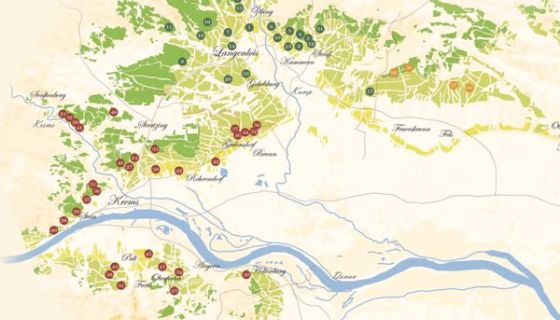Out with Neusiedlersee-Hügelland and Mittelburgenland, in with Ried, or single vineyard. These and other long-discussed amendments to Austrian wine names have at last been incorporated into official wine law. Appellations and quality designations have been a work in progress for many years, as I discussed last year in Austria wrestles with vineyard classification. (The map shows the work in progress in Kremstal and Kamptal to identify top vineyard sites.)
There are significant changes with regard to regional names, increasing emphasis on single-vineyard wines and greater respect for sparkling wine. These complement the development of the DAC classification, which Willi Klinger, head of the Austrian Wine Marketing Board, has been developing with dogged persistence and the co-operation of local growers’ associations since he took up office in 2007 (the first Districtus Austria Controllatus was created in 2002).
REGIONS
Burgenland has always been a bit of a confusing mess of names and has been simplified:
- Neusiedlersee, Neusiedlersee-Hügelland, Mittelburgenland and Südburgenland as general wine-region names have been replaced by Burgenland.
- Only DAC wines within Burgenland may be labelled more specifically, as Neusiedlersee DAC, Leithaberg DAC, Mittelburgenland DAC or Eisenberg DAC.
- Südburgenland replaces the previous subregional designations Pinkatal and Geschriebenstein (though I confess I had never heard of the last two, let alone seen them on labels).
- Süd-Oststeiermark has been renamed Vulkanland Steiermark, apparently because it is ‘more expressive in the conceptual sense’ (not the most helpful explanation but I assume it is thought to indicate the volcanic nature of the region).
SINGLE-VINEYARD WINES AND INDICATION OF ORIGINS
As explained in Austria wrestles with vineyard classification, the process of identifying and mapping top vineyard sites is being undertaken at a local level throughout the country.
- Single-vineyard wines must now be labelled Ried X, where Ried means 'vineyard' and X is the name of the vineyard site that has been legally defined. This will outlaw the fantasy names used by some producers to give the impression of site specificity. Until now, the term Ried could appear on labels but it was not legally regulated or required,
- DAC wines in Kamptal, Kremstal and Traisental are in three tiers: Regional, Village and Single Vineyard, each level having a minimum alcohol content.
RUSTER AUSBRUCH
- These sweet elixirs are now legally defined as Trockenbeerenauslese wines.
- Only wines from Rust may be labelled Ausbruch.
SPARKLING WINE
In order to try to raise the profile of Austrian sparkling wine with a specific designation of origin, stricter rules are to be imposed:
- Austrian Sekt with Protected Designation of Origin can be sold only when labelled with one of the defined terms Klassik, Reserve or Grosse Reserve.
- Wines will be labelled Österreichischer Qualitätsschaumwein or Sekt plus the name of the protected designation of origin (in the cases of Klassik and Reserve, just the name of the Austrian federal state; in the case of Grosse Reserve, federal state and municipality or part of it; in special cases also Grosslage or Ried) and the term geschützte Ursprungsbezeichnung (Protected Designation of Origin) or g.U.
- When the labelling regulations come into force, they will also establish standards with regard to methods of vinification, time on the lees, alcohol content and residual sugar content.
I cannot begin to imagine the many hours spent debating these changes but I hope they were lubricated by the liquid they were discussing. At first glance, the changes to regional names and the introduction of the term Ried look good to me – clear and not simply cosmetic – but the ones for sparkling wine look rather confusing at the moment, although the introduction of stricter designations and winemaking standards should in the long run help improve the quality of Austrian fizz, or at least give wine drinkers an idea of what they can expect once they have mastered the terminology.
A good day for label designers and printers.













